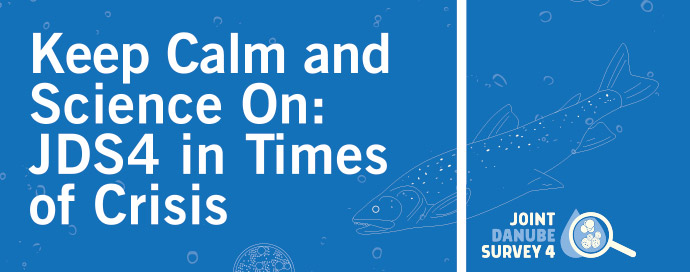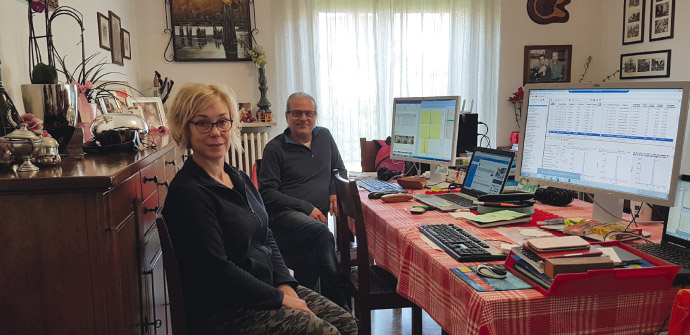Danube Watch 1/2020 - Keep Calm and Science On: JDS4 in Times of Crisis

Mr. Giulio Mariani, please begin by introducing yourself to us, and explaining a bit about your speciality in JDS4 including the substances you work with.
I am a technical analytical chemist who has been working in this field for 35 years. Since 2004, I have been working at the Joint Research Centre of the European Commission in Ispra (IT). I am specialised in gas chromatography coupled with mass spectrometry with a special focus on the analysis of persistent organic pollutants (POPs) such as Dioxins, PCBs, pesticides, flame-retardants and new emerging compounds.
During my career, I have analysed a wide set of environmental and industrial matrices such as soil, sediment, biota, human blood, air, inland and marine water, liquid and solid effluents from Waste Water Treatment Plants and incinerator plants, etc. I also gained experience in the creation of sampling equipment for their collection (see articel: More Efficient Sampling
with the Mariani Box).
I am currently working at the Sustainable Resources Directorate of the JRC in the Water and Marine Resources D.2 Unit. Therefore, the focus of my actual activity is “water”.
The chemical cocktail of organic pollutants present in environmental waters makes the analysis of this matrix quite challenging due to their different chemical characteristics, the multitude of different analytical approaches available and the logistical aspects involved in the sampling exercises.
What are some highlights so far of JDS4 for you? Why is it important too? What is special about JDS4 compared to the previous surveys?
During my working time at JRC, I was fortunate enough be able to participate in three Joint Danube Surveys (JDS) i.e. JDS2, JDS3 and JDS4. Throughout the different exercises, which have covered a time interval of 12 years, substantial scientific and technological innovations were made available and the most advanced approaches have been applied in the execution of JDS4.
Unlike in previous exercises, during JDS4, the research boat was not used to cruise the river and this made, in some ways, the execution of the entire campaign more challenging. In response to these new challenges, the use of newly developed sampling devices and an increased collaboration among different teams provided new strategies for the accomplishment of the survey. Additionally, in JDS4, effluents of Waste Water Treatment Plants and underground waters coming from different countries were studied too.
Teams from different countries and research institutions applied different approaches both towards sampling and analysis, thus offering the possibility to produce wider datasets. Results from different sampling approaches (active vs. passive sampling techniques vs. extra-large volume sampling) and data obtained from both target and non-target analytical method applications could be compared. This increased the coherence of the entire scientific exercise.
Furthermore, chemical data will be useful for the characterisation of the newly developed effect-based monitoring tools.
Datasets derived from different approaches will serve the characterisation of the health-status of the river, indicating any further need for intervention.
It is worth mentioning that since 2016, our laboratory has been involved in international water monitoring projects on the Black Sea. Being that this is a related activity to JDS4 in 2019, we decided to monitor the same set of chemical compounds in order to provide a useful dataset for the evaluation of possible input and correlation of pollution from the Danube River into the Black Sea.
JDS4 revealed itself once more an important “test-bed” for comparison among different approaches and technologies, thus bringing the scientific community towards continuous growth.
How has working from home – or under lockdown conditions – during this crisis been affecting your work?

Giulio Mariani & Simona Tavazzi, Directorate D, EC-JRC
It has been quite challenging, especially in the beginning. Suddenly we could not enter the JRC site and could not move anywhere. Restrictions regarded every aspect of our social lives, including schools and shops. Only food shops and pharmacies were open.
For a laboratory involved in experimental activities like ours, even a partial lock-down would have arrested any progress on the projects. A complete lockdown, like the one imposed on us, arrested all the experimental activities. Fortunately, the lockdown started just after the end of the analytical part.
In half a working day, we had to move our offices to our homes, including all the necessary documents, working stations, connections, etc. Considering that we were running several different projects, we had to be sure not to forget any important materials for following up.
From home, we could process all the collected analytical data and finalise different projects, including JDS4, while respecting the planned deadline.
This latter aspect especially was quite critical because we were at that time – and continue to be – in the centre of the Corona madness (i.e.: Lombardy), where the restrictions were stronger and the psychological pressure higher, compared to other geographical areas.
More generally, what are the specific concerns that have been facing the scientific community (and community generally) in Lombardy throughout this pandemic?
Since February, Italian hospitals have been invaded by an indescribable number of SARS-CoV -2 patients, without having any clear idea on efficient treatments or therapies. After three months, some experimental protocols have been identified for the treatment of Covid-19. But the emergency is not over. Furthermore, other scientific fields started to study different aspects of the virus, including its environmental presence and spread.
What are the key outcomes of your work so far in the survey? What do they mean?
The dataset produced by the JRC (as an in-kind contribution) is available for use by the ICPDR and national regulators, and can help to improve their understanding of the levels of water contamination in the Danube River and to undertake any possible ameliorating actions.







